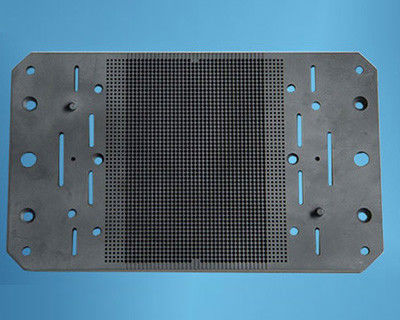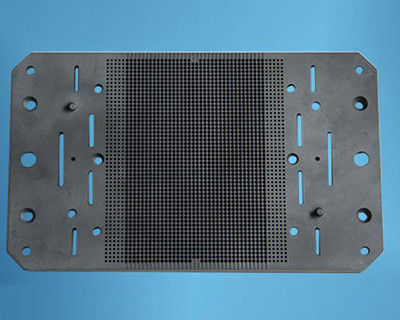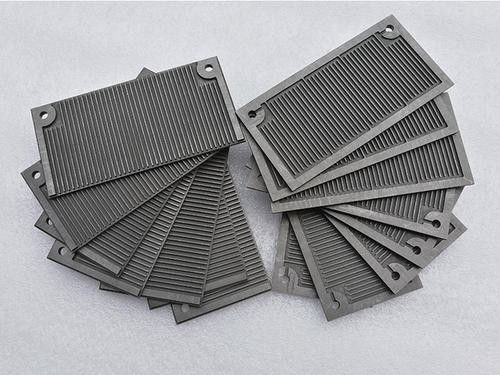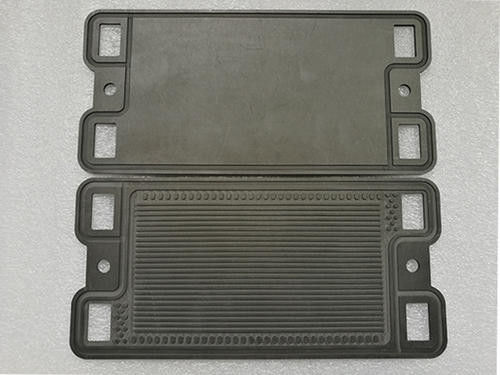Bipolar Plates
Bipolar Plates,Used in DMFC and PEMFC systems, as well as redox flow cells
Our bipolar plates for fuel cells were developed for the heavily fluctuating PEMFC (Proton Exchange Membrane Fuel Cell) and DMFC (Direct Methanol Fuel Cell) markets. Through intensive research, we have been able to combine cost-effective production with outstanding material properties. Both are valued by leading fuel cell manufacturers across the globe, a fact reflected in the more than 700,000 plates produced to date. Our bipolar plates are characterized by a very high proportion of graphite, which achieves outstanding electrical conductivity, as well as corrosion resistance, mechanical strength and flexibility.
Material Technical Specifications:
|
Type
|
Max Grain size mm
|
Bulk Density g/cc
|
Specific resistivity μΩ.m
|
Flexural Strength Mpa
|
Compressive Strength Mpa
|
C.T.E(100-600℃)
x10-6/℃
|
Ash %
|
|
ZGB-I
|
0.8
|
≥1.68
|
≤9.5
|
≥13.0
|
≥28.0
|
≤2.8
|
≤0.3
|
|
ZGB-II
|
0.58
|
≥1.72
|
≤8.5
|
≥15.0
|
≥32.0
|
≤2.4
|
≤0.3
|
|
ZGL-0
|
2
|
≥1.58
|
≤11.5
|
≥7.0
|
≥18.0
|
≤3.0
|
≤0.3
|
|
ZGL-I
|
2
|
≥1.68
|
≤9.0
|
≥13.0
|
≥28.0
|
≤2.7
|
≤0.3
|
|
ZGDJY-C1
|
22
|
≥1.78
|
≤10
|
≥38.0
|
≥65.0
|
≤3.9
|
≤0.07(Normal)
≤0.005(Purified)
|
|
ZGDJY-Y3
|
22
|
≥1.86
|
≤13.0
|
≥40.0
|
≥80.0
|
≤3.9
|
≤0.07(Normal)
≤0.005(Purified)
|
|
ZGDJY-W5
|
22
|
≥1.85
|
≤12.0
|
≥45.0
|
≥90.0
|
≤4.3
|
≤0.07(Normal)
≤0.005(Purified)
|
|
MY-III
|
45
|
≥1.83
|
≤10.0
|
≥38.0
|
≥80.0
|
≤3.5
|
≤0.1
|
|
MY-IV
|
45
|
≥1.88
|
≤9.0
|
≥42.0
|
≥90.0
|
≤3.8
|
≤0.07
|
|
If you can not find the material which you need, please kindly contact us ,we will choose apporpiate materialaccording to customer's application (working condition)based on rich experiences in graphite application
|
You benefit from these advantages:
-
A unique level of development in material expertise and molding technologies
-
Used in DMFC and PEMFC systems, as well as redox flow cells
-
Can be produced as blanks, milled versions and PTS variations, according to the customer's wishes
-
Prototype production possible
Features:
-
Excellent thermal durability
-
Good thermal conductivity
-
Resists wetting by molten metals
-
Complex shapes can be processed
-
Reduces metal sleeve weight
-
Various surface modifications and treatments enable a variety of applications
Due to its ability to resist wetting by molten metals, graphite is used as a mold material for strip dies, tubular dies, and other molds used in continuous casting processes for copper and copper alloys (brass, bronze, and nickel silver), aluminum alloys, cast iron, precious metals, and a variety of other metals.
Graphite can be used with different continuous casting methods (horizontal/vertical) and can be produced in a variety of ingot shapes (including plates, strips, pipes, rods, wire, and contoured shapes).
With a wide range of grades available, we can select the optimal grade for a variety of cast metals and alloys.
We manufactures products from structural brands of graphite, impregnated graphite, antifriction graphite
Graphite has unique properties:
-
electrical conductivity;
-
heat resistance (sublimation effect);
-
poor wettability by many metals;
-
strength, anomalously increasing with temperature increasing;
-
possibility to work with dry friction (self-lubrication)
Due to its unique properties, graphite products are used in many industries:
-
production of ferrous, non-ferrous and precious metals;
-
engineering;
-
chemistry, petrochemistry and oil refining;
-
glass industry;
-
analytical laboratories;
-
power engineering and electrical engineering.







 Your message must be between 20-3,000 characters!
Your message must be between 20-3,000 characters! Please check your E-mail!
Please check your E-mail!  Your message must be between 20-3,000 characters!
Your message must be between 20-3,000 characters! Please check your E-mail!
Please check your E-mail! 



